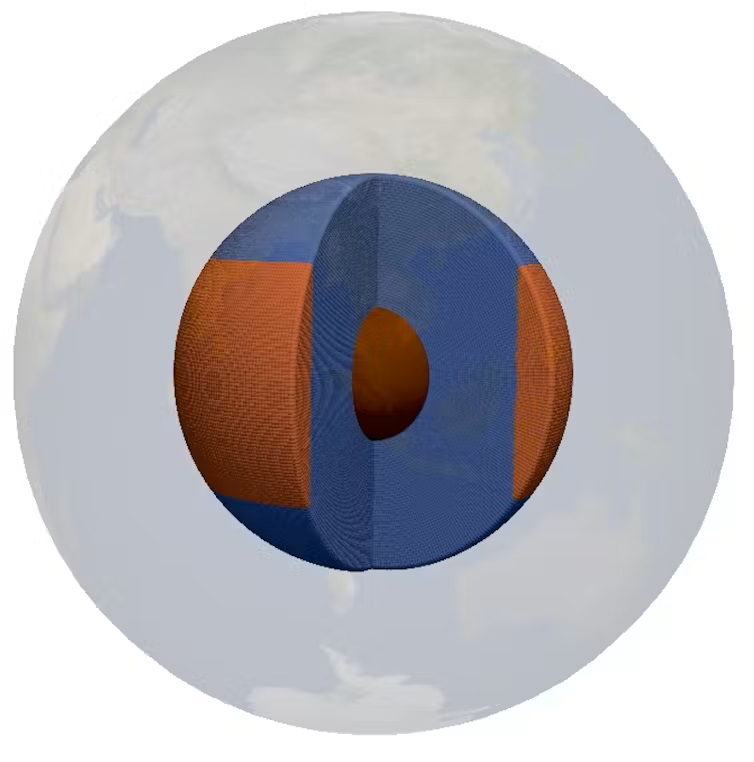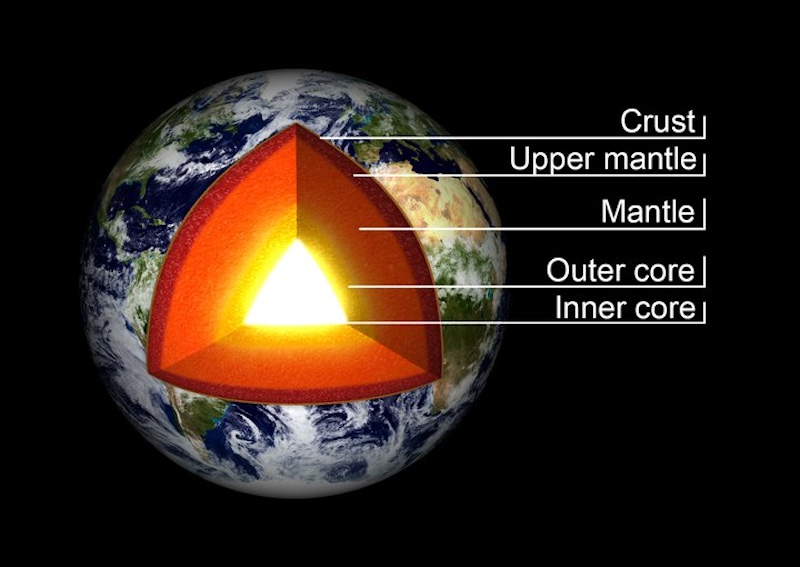
- Earth’s core is in two parts, an inner solid core and a liquid outer core.
- Scientists just discovered a large donut-shaped region within the outer core. They used a new method of measuring seismic waves to find it.
- Earth’s magnetic field is powered by the liquid outer core. The discovery provides new clues about the dynamics of the magnetic field.
New discovery from Earth’s interior
We think of Earth’s interior as being rather simple, with the mantle surrounding an inner core. It’s a bit more complex than that, though. There is an inner core, which is solid, and an outer core, which is liquid. And now, scientists have discovered a donut-shaped region on top of the outer core. On September 3, 2024, researchers at Australian National University said they found the donut-shaped feature by analyzing seismic waves passing through the core. The donut rests on top of the outer liquid core, where the core meets the mantle.
The seismic waves move 2% slower through this donut region. Geophysicist Hrvoje Tkalcic and Xiaolong Ma led the new study about Earth’s core. Tkalcic wrote in The Conversation:
We think this region contains more lighter elements such as silicon and oxygen, and may play a crucial role in the vast currents of liquid metal running through the core that generate Earth’s magnetic field.
The scientists published their peer-reviewed findings in Science Advances on August 30, 2024.
A giant donut in Earth’s core
The researchers discovered the donut-shaped region by studying how seismic waves move through Earth’s core. They found the waves moved slower through the donut than the rest of the outer core. This made it possible to map out the shape, size and location of the donut.
The donut sits on top of the outer liquid core. This is where the liquid core comes into contact with the surrounding mantle. Tkalcic also said:
The region sits parallel to the equatorial plane, is confined to the low latitudes and has a doughnut shape. We don’t know the exact thickness of the donut, but we inferred that it reaches a few hundred kilometers beneath the core-mantle boundary.
The donut feature had remained undetected until now, the researchers said.

A new way to measure seismic waves
The researchers measured seismic waves – like those generated by earthquakes – to make the discovery. For this study, however, they took a bit of a different approach. Usually, scientists will study the seismic signals within the first hour after an earthquake. But this time, they waited until hours later. This revealed the low speed of the waves through part of the outer core. Tkalcic explained:
By understanding the geometry of the paths of the waves and how they traverse the outer core’s volume, we reconstructed their travel times through the Earth, demonstrating that the newly discovered region has low seismic speeds.
The peculiar structure remained hidden until now as previous studies collected data with less volumetric coverage of the outer core by observing waves that were typically confined within one hour after the origin times of large earthquakes.
We were able to achieve much better volumetric coverage because we studied the reverberating waves for many hours after large earthquakes.

Mysteries of the Earth’s core and magnetic field
The discovery of the donut will help scientists solve mysteries about both Earth’s core and magnetic field. Ma said:
There are still mysteries about the Earth’s outer core that are yet to be solved, which requires multidisciplinary efforts from seismology, mineral physics, geomagnetism and geodynamics.
As Tkalcic also noted:
Our findings are interesting because this low velocity within the liquid core implies that we have a high concentration of light chemical elements in these regions that would cause the seismic waves to slow down. These light elements, alongside temperature differences, help stir liquid in the outer core.
In addition, the composition of the outer core is directly tied to the behavior of the magnetic field. Understanding this better will help scientists know when it might weaken. And that, of course, is essential, since the magnetic field helps to protect all life on Earth from dangerous radiation coming from the sun. Tkalcic said:
The magnetic field is a fundamental ingredient that we need for life to be sustained on the surface of our planet.
The dynamics of Earth’s magnetic field is an area of strong interest in the scientific community, so our results could promote more research about the magnetic field on both Earth and other planets.
Bottom line: Scientists in Australia have discovered a huge donut-shaped region in Earth’s core. The finding provides new clues about the dynamics of Earth’s magnetic field.
Via Australian National University
Read more: Earth’s lopsided core? Strangeness in our planet’s interior











